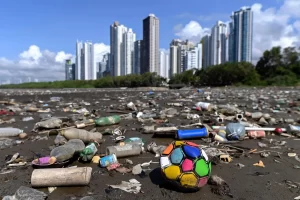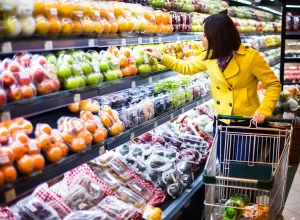Plastics

Remember the 1960s movie The Graduate, where Dustin Hoffman is taken aside by Mr. McGuire, who says to the young man just setting off on his way to a career, “Just one word: plastics! There’s a great future in plastics. Think about it.” “I will,” says Hoffman. “I will.”
Many of us thought not enough about it. Like the leggy Mrs. Robinson later in the film, the petrochemical industry lured us to a way of packaging things that worked pretty well until the time came to face the consequences. It was cheap. It was convenient. Those two pillars of successful consumerism. Now the world is awash in plastic products. Buried in it, in fact.
Some 8.3 billion tons of plastics have been produced since the 1950s and most of it is still with us, amassed in landfills, clogging waterways, floating by the tons in our oceans, and even worse, accumulating in the bodies of wildlife and humans. It doesn’t go away. It just continues to aggregate (HERE).

You would think we’ve reached a time of reckoning. You’d think we might be ready to say enough is enough. Don’t count on it. Estimates are production of plastics may increase three to four fold (HERE) and may account for 20% of all petroleum consumption by the middle of the century (HERE). If so, plastics in the earth’s oceans by then may weigh more than all the fish still trying their best to live there (HERE).
What Mr. McGuire recognized all those years ago is that plastic is a wonder material: cheap, lightweight, and extremely durable. So durable in fact that it’s very difficult to get rid of, once it has been used. Despite what we are told by the spinmeisters who market it, very little plastic is recycled and most of it is for single use products. Then it becomes trash that takes hundreds of years to decompose. Who makes most of it (HERE)?
Why do we keep using it? Convenience. At least until it comes time to dispose of it. Then we mostly send it to third-world countries. But on the front end, it is very convenient and not easily replaced.

Do you think about plastic when you go grocery shopping? I do. I shop at the local Co-op, which is proudly organic, non-GMO, lactose-free, gluten-free, free of nearly every damn thing you can imagine as a shopping option – except plastic. It is everywhere, covering all that free-range chicken and grass-fed beef with cling wrap, housing the organic olives and heat-free pickles in hard plastic tubs, cradling the freshly roasted and ready-to-eat nicely herbed chicken and dilled salmon, wrapping the bakery goods, rolls of ready bags for all the carefully manicured produce, and in all the containers of every type and size that house all those expensive herbs, vitamins, minerals, potions, and beauty products. It’s truly frightening!
Credit where credit’s due: Rise Up Bakery (HERE) wraps its goods in compostable cellulose. And the bread is damn good, too. A great combination. There may be others who do it, but too few.
To the Co-op’s credit, there are the attractively priced, in-house canvas bags for carrying all those plastic-wrapped goods from the check-out counter to your car and home, where all that food eventually is consumed and all the plastic blithely disposed of in the trash. And if you believe those little triangles on the bottom of so many of those containers, the ones that alert you to the claim these products are recyclable, forget it. Don’t fool yourself (HERE).
The plastics lobby will tell you it’s your problem if you don’t recycle all that stuff they offer you. They make a lot of it in recyclable form. But it’s a ruse, another form of consumerizing blame (HERE). Ask your recycling service and they’ll tell you straight out. It’s possible but not practical. It simply isn’t happening. Almost all that stuff from your plastics recycling container ends up in landfills. May as well just toss it in your trashcan.
New plastic is so much cheaper than recycled that nobody is repurposing the stuff. Recycling just ain’t so. Those very same folks who stamp the triangle on the package know full well it’s headed for the trash. Not cost effective to reprocess it, but we did what we can do, you know, we played the game, so baby, it’s your problem now.

What to do? There is work being done to create viable substitutes for plastic packaging. Plant-based, edible and tasteless sprays are being developed that can shield vegetables from oxygen and retain moisture to extend shelf life, eliminating shrink-wrap plastics from the cycle.
Bioplastics derived from sugars of sustainable plants are being developed for bottles, films, and other packaging. They are claimed to be completely recyclable and capable of decomposing in a couple of years if abandoned. There even are plastics being created from microbes that feed on carbon sources and generate a fatty substance that behaves very much like plastic, except that it literally recycles itself by reverting to a bacterial state when it returns to a natural environment (HERE).
There are innumerable interesting, even exciting options to petrochemical plastics that are being developed for a range of packaging needs (HERE). But cost will always be disadvantageous by comparison. Plastic is way cheap. The only meaningful solution may be in assessing the actual life-cycle cost of the product at the point of sale.

How to price in pollution is always a debatable issue, but the true cost of plastics from petrochemicals through their entire life cycle from mining them to disposal is certainly substantial. Currently, we’re only costing them up through distribution. Not for the damage done in acquiring the raw material. Nor paying for their disposal.
Initiatives toward Zero Waste in product cycles are increasingly compelling, both locally and nationally (HERE), and globally (HERE). Until we achieve such goals, we really need to factor the entire cost of a product that ends up in a landfill, or worse, in our natural environment as a millennial occupant, settling in for many hundreds if not a full thousand years. If you bring it into the world, you need to price in the carrying cost all the way to the end, whenever and wherever that may be.
There are some ambitious efforts underway to deal with the problem of plastics in the environment (HERE). Nobody is pretending it’s a simple issue. Rather, it’s part and parcel of the entire climate change equation, a global crisis that demands attention because it isn’t going to improve without radical change in what we do and how we value it.
I do think about plastic, all the time – hate it and try to avod purchasing items in it, but it is nearly impossible to completely avoid it. I grow much of my own food and try to jar as much as possible in glass. I also try to uy only glassed or bixed foodstuffs. Items that go into the freezer pretty much have to go in plastic. I am looking for an alternative and have purchased compostable, sealable bags, but am afraid to put my foods in them in the freezer thus far. Will get my courage up soon and try them.
It’s really discouraging, both because plastic is so pervasive and ultimately so destructive to the environment, but also because there’s so little incentive for industry to create substitutes. Plastic is oppressively cheap to manufacture and until the cost of the damage it causes is factored into the cost, nobody can compete on price.